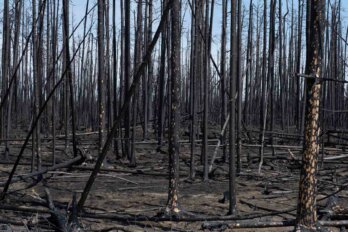Last summer, the plight of the southern resident orcas—which migrate along the craggy Pacific shoreline between southeastern Alaska and central California and are icons of the Salish Sea—turned dramatic and inescapably anthropomorphic. A new mother , J35, carried her deceased calf draped over her nose throughout the coastal waters, buoying it for seventeen days. The public outpouring in response was swift. How could you not cry? Here was a mother that could not let go of her child, which had died in a marine habitat that’s a watery flashpoint for political and economic debate in western Canada. At the same time, scientists had sounded the alarm that some of the orcas were starving to death: the Chinook salmon population that the resident orcas rely on is endangered too. The whales were a perfect backdrop on which to project what scholar Kriss Kevorkian calls “environmental grief”—a reaction that stems from the loss of ecosystems.
There are currently only seventy-six southern resident orcas left in the world, split between pods, dubbed J Pod, K Pod, and L Pod, which communicate by distinctive “dialects,” or sounds. Their historical population data has only been reliably tracked since 1974, at which time there was around seventy. Our best guess is that the population has never dipped below sixty-seven, in 1971, from which the population was able to rebound. Still, only two of the calves born in the last four years have survived, and the prospect of hitting seventy again is now within sight. Even Fisheries and Oceans Canada says that a number this low indicates their survival is in “imminent threat.” They are currently not expected to rebound to such a point as to be removed from endangered status—in fact, in 100 years they could be gone completely.
The southern resident orcas are endangered for three main reasons: a decrease in salmon spawning in their habitat, noise and physical disruption from vessels of various sizes, and ocean contaminants like DDT (which lingers in our environment despite the fact that it’s been banned), pesticides, and chlorine from processes like pulp and paper bleaching. That their extinction is so closely tied to the degradation of their habitat has linked them inextricably to national conversation surrounding the expansion of the Trans Mountain Pipeline, which would increase tanker traffic along British Columbia’s coast sevenfold. When the Federal Court of Appeal released its report on Trans Mountain last summer, in which it ruled that the National Energy Board failed to properly assess the impacts of marine shipping and to properly consult with First Nations, the whales were mentioned fifty-seven times in 200 pages.
The orcas also inhabit existential territory, embodying the tensions between environment and economic expansion. In May, solutions meant to mitigate risks to their habitat were outlined by the Fisheries and Oceans and included a voluntary slow-down zone for vessels (tankers, ferries, and also whale-watching boats) in southern resident habitat and increased regulatory controls of contaminants. “We are at a crossroads,” acknowledged fisheries minister Jonathan Wilkinson, at the announcement. “The impacts of climate change, combined with habitat loss associated with human activity over the past several decades, have resulted in ecosystem degradation here in Canada and around the world.”
It feels like this year’s environmental news has thrust us into that crossroad. We’ve been bombarded with updates on ecological dismay and study upon study driving home just how bad things have become, how the status quo has been, likely irreparably, upturned. If there is no longer a normal, then maybe the solution could be found in the unconventional.
In early May, Michelle Bender, who researches the legal rights of marine ecosystems at the Earth Law Center in Spokane, Washington, offered a plan. Working with other American NGOs, community groups, scientists, and Indigenous communities, all situated along the Salish Sea, she has spent the last year working on a declaration and petition that argues we should grant legal personhood to the southern resident orcas.
“They’re an iconic species, and there’s no denying they’re sentient and intelligent,” she says. “With everything going on, carrying the dead baby received so much outcry….[It’s an] easy sell at this point, I feel like.”
The same day that Bender outlined her plan to me, the United Nations released a report that was staggering in both scope and message: a million animal and plant species are currently threatened with extinction. Some could be gone within decades. Prepared by 145 expert authors with input from 310 contributing authors from around the world, working under the banner of the Intergovernmental Science-Policy Platform on Biodiversity and Ecosystem Services (or IPBES), the report outlines how biodiversity is declining at rates unprecedented in human history. What was once normal—losing about one to five species per year—is now out of control: we’re now looking at rates more than 1000 times that. This scale of loss, the report says in uncharacteristically blunt language, is “ominous.”
The report points forcefully towards the actions of humans for this massive tragedy, because of poor agricultural management, urban sprawl, plastic pollution, or overfishing: “We are eroding the very foundations of our economies, livelihoods, food security, health, and quality of life worldwide,” said IPBES chair Robert Watson. Species such as the orangutan, black rhino, and Sumatran tiger may soon only be known in textbooks. So too could the southern resident orcas.
In 2016, the federal government unveiled its $1.5 billion Oceans Protection Plan, shortly before announcing it would approve the Trans Mountain Pipeline expansion. In the wake of J35, Fisheries and Oceans announced that it would undertake consultations before adopting a new management plan for the whales. In an email to The Walrus, Fisheries and Oceans stated that personhood is a legal issue left to the courts.
In early May, Linda Nowlan, a lawyer at British Columbia’s West Coast Environmental Law (WCEL), submitted the firm’s response to that consultation process. After outlining the firm’s concerns and recommendations with the DFO’s proposed changes, the response outlined a “bold new move”—granting whales legal personhood. “Because [protection measures haven’t] worked to stop the decline of the species, we’re saying new approaches should be tried,” she said at the time.
WCEL’s proposal, which echoes Bender’s argument, does not grant whales the status of “natural persons,” like every person in Canada has. And it’s unclear how exactly they would be treated if granted judicial personhood. But, by granting whales this personhood, their interests might then be considered alongside human and economic demands at the negotiating table, where they would be represented by designated guardians. “You give [the orcas] legal rights so then they have representation in decisions. So when it comes down to discussing the Trans Mountain or anything that might have an effect on the orcas or their habitat, then they have to be part of the decisions,” Bender says.” Their interests and their voice will be represented.”
The idea is not, in practice, radical. Earth Day, celebrated every April 22 since 1970, was born in Pennsylvania—it started with one man’s idea to “give our natural environment the same kind of constitutional protection that [is] given to our political rights.” After edits that framed the proposal in more anthropocentric terms (that peoples have rights to clean water and air, for example), a amendment recognizing environmental rights in the state’s constitution passed in May 1971. Since then, New Zealand has granted legal personhood to a river, and both Ecuador and Bolivia had granted legal personhood to their entire natural environments. Last year, Colombia’s Supreme Court granted personhood to the reaches of the Amazon within its borders. And, in February of this year, the city of Toledo, Ohio, granted Lake Erie legal personhood in a bid to help protect it from agricultural runoff.
In all these cases, the personhood framework was granted on the foundation that ecological rights could not be separated from human rights. Notably, “the concept has been driven by Indigenous peoples,” says David Boyd, the University of British Columbia professor currently acting as the United Nations special rapporteur on human rights and the environment and author of The Rights of Nature. But, in Canada, previous attempts to preserve land, like the Ktunaxa Nation’s bid to ensure the preservation of a sacred alpine valley from ski-hill development, have failed (the nation argued the importance of the land was rooted in “freedom of conscience and religion,” as opposed to environmental protection or Aboriginal title).
In fact, even the southern resident orcas are but a stepping stone towards a larger request. Written and prepared in partnership with Bender’s firm and other associations, the petition for orca personhood on the West Coast of US is tied to a larger desire to grant personhood to the Salish Sea overall. “We found it was hard [for people] to grasp onto the sea,” says Bender. But with an orca, they get it.
The fact of cetacean consciousness—that marine mammals like whales and dolphins are sentient beings—has gained increasing traction in our public knowledge. After the documentary Blackfish was released, the world pressed its nose against the glass between us and whales kept in captivity, and we did not like what we saw. That movie was, writes Casey M. Weed of the University of Maine School of Law, “An introduction to the darker reality of what our society has done to these highly intelligent animals.” On June 10, the House of Commons passed what’s being called the “Free Willy” bill, which outlaws holding whales and dolphins in captivity.
“Some of the very best scientific evidence that can be fed into the personhood argument can be applied to killer whales,” says Hal Whitehead, a biologist at Dalhousie University who, a decade ago, contributed to a Declaration of Rights for Cetaceans, which has been championed by a group of eleven experts whose research has spurred them to agree cetaceans that have a right to life. Whales, with their massive brains, intricate communication systems, and cooperative societies, are more like us than we may think. “We have pretty clear evidence from the [orcas] that they have extremely sophisticated social and communication structures in which there is an immense amount of communication going on,” says Whitehead.
We can so easily empathize with the whales held in an aquarium, but our connection with those in the seeming wild becomes more complicated. The gut reaction of many who rely on coastline economies for their livelihoods is quick cynicism—if not to the idea of personhood itself, then to its feasibility. Nowlan agrees that the idea can sound “outlandish.”
Still, it’s been nearly fifty years since the first Earth Day and we’re now facing down the sixth mass extinction, an epoch in which “we are losing the web of life.” Protesters have been gluing themselves to buildings in London to draw attention to global inaction surrounding these concerns. “This is like a David and Goliath where there’s multiple Goliaths,” says Boyd, who moved to Pender Island, off British Columbia’s coast, in part because he had seen, and loved, the southern residents while on a previous trip. “What’s holding [legal personhood] back in Canada is the fact that it’s never happened before,” he says.
Boyd and Nowlan both cite the opportunity for local coastal governments to make a declaration recognizing the whales’ rights, which would require those governments to stand up against layers of regional, national, and international economies that have a vested interest in access to the waters that the orcas live in. This could stretch beyond controversial oil tankers and include tourist whale-watching boats, container ships, and fishing vessels and would limit the operations that come along with them. Likewise, investment would have to be redirected to promote habitat restoration for Chinook salmon, rather than simply farming them. Another opportunity would be for a public-interest environmental-law group to bring forth a lawsuit on behalf of the whales against government or industry. Nowlan and WCEL might consider something similar as an option, in collaboration with First Nations that are “best placed” along the coast, if the right circumstances arose.
If we were to follow in New Zealand’s steps, it would then mean formalizing an act and establishing a board to represent the southern residents in development and habitat-management talks. (For New Zealand’s Whanganui River, also known as Te Awa Tupua, this is a governing body consisting of two representatives, one chosen by the government and one by the Māori.) For Te Urewera, a former national park in New Zealand that’s now considered a legal entity, the board consists of four Tūhoe (a Māori group) and four Crown representatives that produce management plans and “speak as its voice.”
It makes sense, then, that West Coast Environmental Law and the Earth Law Center are interested in proposing a similar approach—a possible federal law that creates a board that would represent southern resident orcas in consultations. Boyd echoes this plan: legally, the whales could be provided with representation responsible for their best interest, not unlike when children are represented in court.
Still, the proposal requires a massive shift not only in how we conceive of animals but of our guiding ethics regarding land as well. Boyd cites the Te Urewera agreement, which requires that businesses enter into “friendship agreements” with the park rather than usage contracts, as an example of the immense change in perception required to undertake legal personhood cases.
The southern resident orcas have been listed as endangered since 2005; what’s new is the context in which J35 surfaced with her calf. The southern resident orcas continue to struggle and other whales have been washing up dead in record numbers along both the east and west coasts of North America. On land, negotiating the terms of their survival, without their voice, has come to feel impossible.





